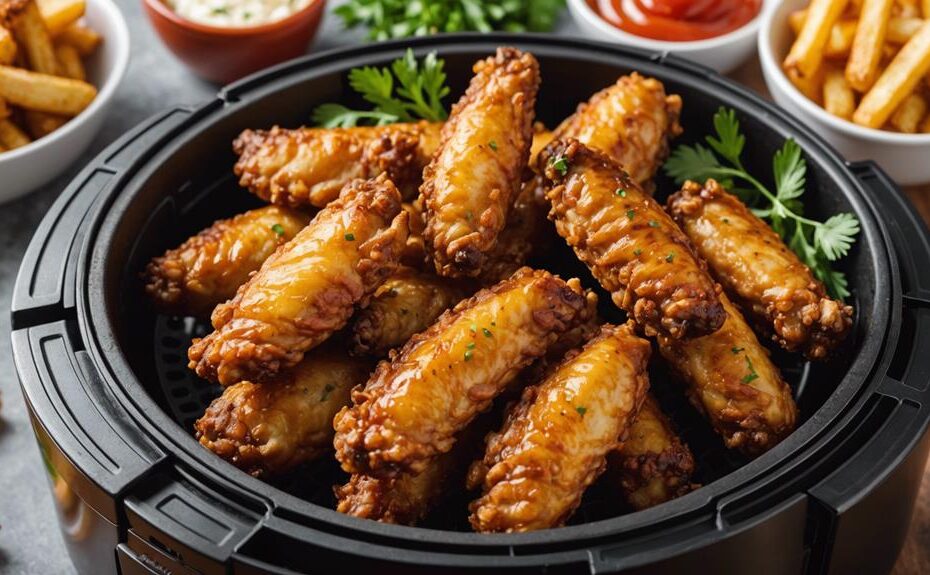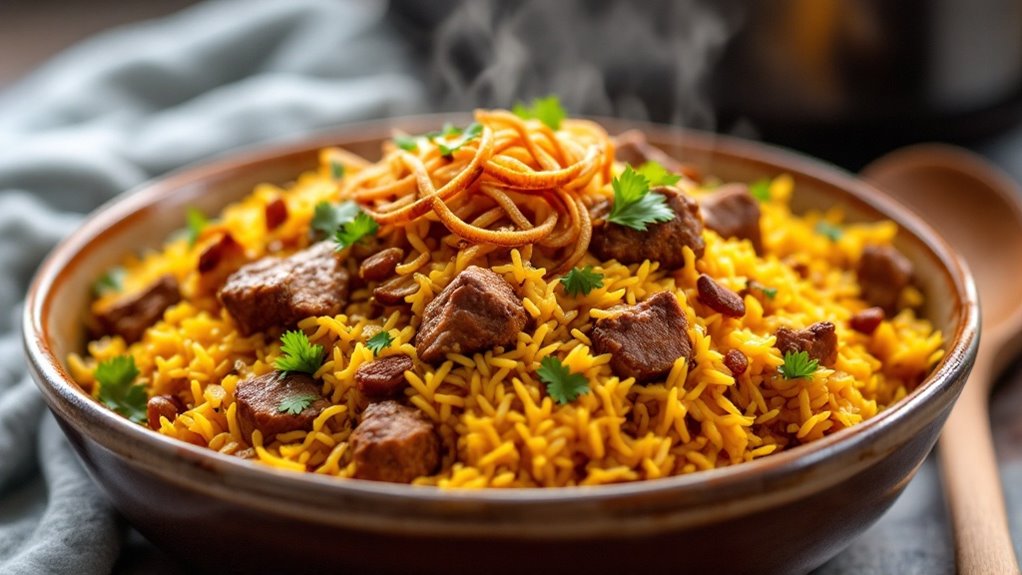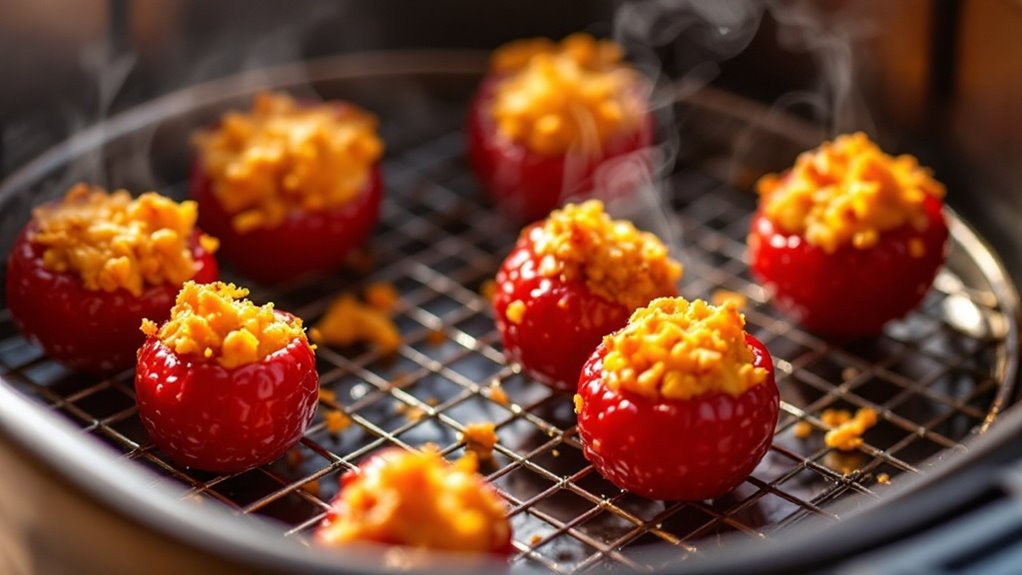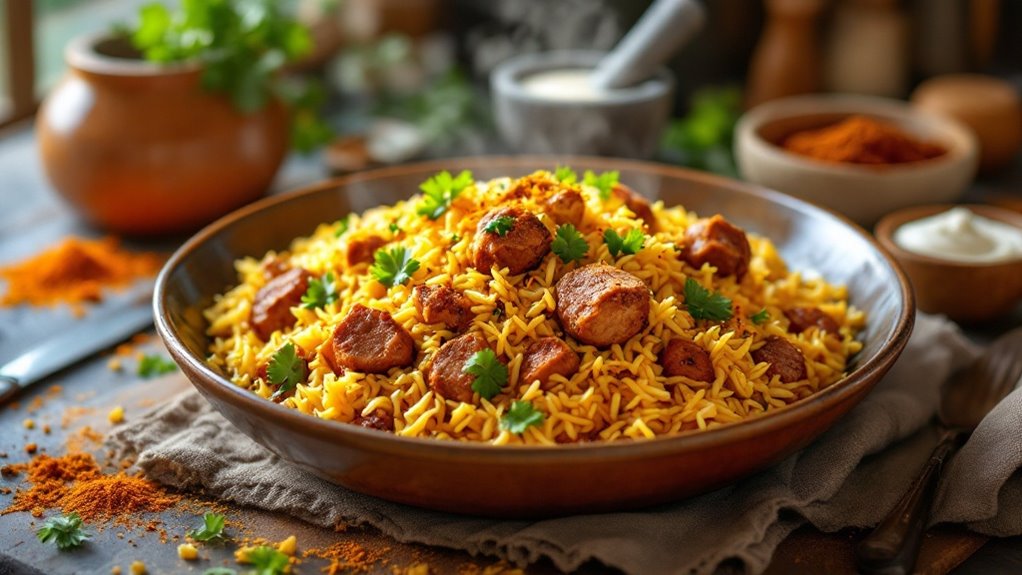Yes, air fryers guarantee food crispy by circulating hot air up to 400°F around the food, creating a crunchy outer layer with minimal oil. This rapid air circulation guarantees even cooking and a golden-brown crust while keeping the interior moist. For maximum crispiness, arrange food in a single layer and lightly coat with oil to enhance the Maillard reaction. The perforated basket design further promotes even airflow for consistent results. Air fryers are ideal for achieving a crispy texture on chicken, vegetables, and even cookies, providing a healthier alternative to deep-frying. Discover the techniques that perfect this crunch.
Key Takeaways
- Air fryers use rapidly circulating heated air to create a crispy outer layer on food.
- They require minimal oil, reducing fat content while achieving a crunchy texture.
- The perforated basket design allows even airflow, ensuring uniform crispiness.
- Hot air circulation retains moisture, leading to a crispy exterior and moist interior.
- Users report air fryers deliver a satisfying crunch similar to deep-fried foods.
How Air Fryers Work
An air fryer uses rapidly circulating heated air, reaching up to 400°F, to cook food, much like a convection oven. This method guarantees the hot air envelops the food, creating a crispy outer layer while maintaining a soft interior. When you place food in the fryer's basket, the circulating air evenly distributes heat, resulting in uniform cooking.
The design of an air fryer makes it a healthier alternative to traditional frying methods. Instead of submerging food in oil, the air fryer requires only a minimal amount of oil, if any. During the cooking process, excess grease drips into a container below the basket. This not only reduces the fat content of your meals but also cuts calories by 70% to 80%.
What's remarkable is that air fryers can achieve a texture similar to deep frying, offering food that's crispy on the outside without the need for excessive oil. Research indicates that air-fried food retains comparable color and moisture levels to oil-fried alternatives. By using an air fryer, you can enjoy the satisfaction of crispy, evenly cooked food while making a healthier choice for you and your family.
Crispiness Comparison
When comparing the crispiness of foods prepared in air fryers to those cooked through traditional deep-frying, you'll find that air fryers achieve a remarkably similar crunchy texture with much less oil. Air fryers use circulating hot air to make food crispy without the need for submerging it in oil. This method not only reduces the fat content but also makes cleanup considerably easier.
The air around the food is crucial in determining its texture. In air fryers, a perforated basket allows for even airflow around the food. This design guarantees that the circulating hot air can reach all surfaces, effectively crisping the exterior while keeping the inside moist and tender. The mechanism to circulate the heat is what makes air fryers so efficient at producing a crunchy texture.
While air-fried foods may not taste exactly like their deep-fried counterparts, they still deliver a satisfying crunch and texture, offering a healthier alternative. The ability to make food crispy with less oil is a significant advantage, not only for health reasons but also for convenience. Overall, air fryers provide a practical way to enjoy crispy foods without the downsides of traditional frying.
Types of Foods
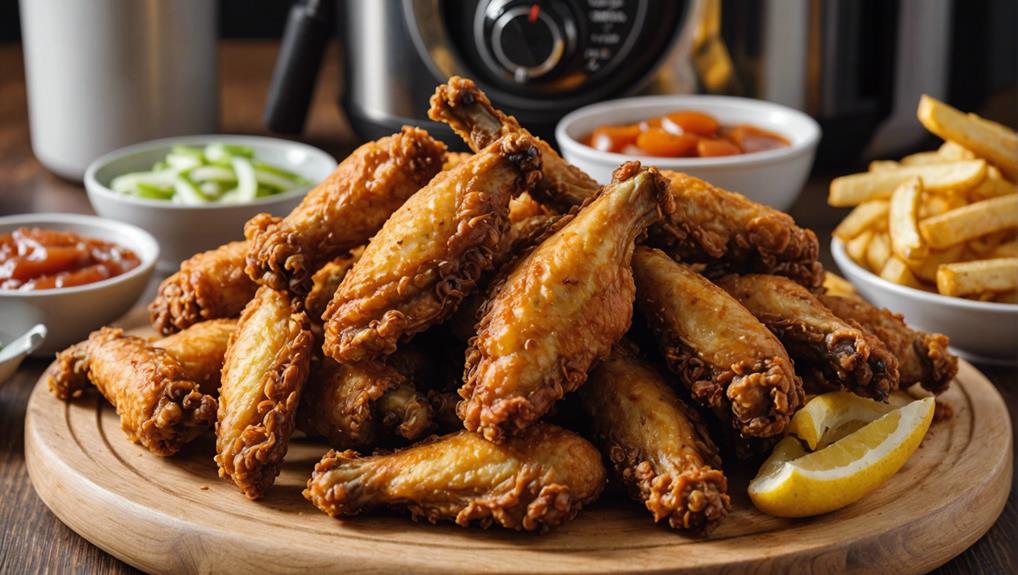
Leveraging the versatility of air fryers, you can achieve a crispy texture on a diverse range of foods, from chicken and fish to vegetables and cookies. This appliance uses circulating hot air to create a crispy exterior without needing excess oil, making it a healthier alternative to traditional frying methods.
Chicken, especially wings and nuggets, comes out particularly well in an air fryer. The hot air guarantees an even, golden-brown crust while keeping the inside moist. Frozen nuggets also benefit from this technology, achieving a satisfying crunch that rivals deep-fried versions. Fish fillets are another excellent option, maintaining a delicate, crispy coating without becoming greasy.
Vegetables like Brussels sprouts turn into savory, crispy delights when air-fried. The circulating air enhances their natural flavors while providing a texture that's both crunchy and tender. Similarly, you can use the air fryer to make cookies with a perfect balance of crispy edges and chewy centers.
Cooking Techniques
To achieve peak crispiness in an air fryer, make sure you arrange the food in a single layer within the perforated basket to allow maximum air circulation. This cooking technique guarantees that the hot air can rapidly circulate around each piece of food, promoting even crispiness. Crowding the basket leads to uneven cooking, as some pieces may block airflow to others, resulting in inconsistent textures.
A light coating of oil is essential to enhance the crispy texture. The oil helps in the Maillard reaction, which creates the golden-brown crust that is characteristic of perfectly air-fried foods. However, moderation is key; too much oil can lead to soggy results.
Utilize the air fryer's temperature settings to achieve the best results. Preheating the air fryer can also contribute to better crispiness by ensuring that the food starts cooking at the desired temperature immediately.
The hallmark of air fryer cooking techniques lies in the rapid circulation of hot air, which allows the food to retain its moisture while achieving a crispy exterior. By following these precise methods, you can maximize the effectiveness of your air fryer for consistently crispy results.
Basket Design
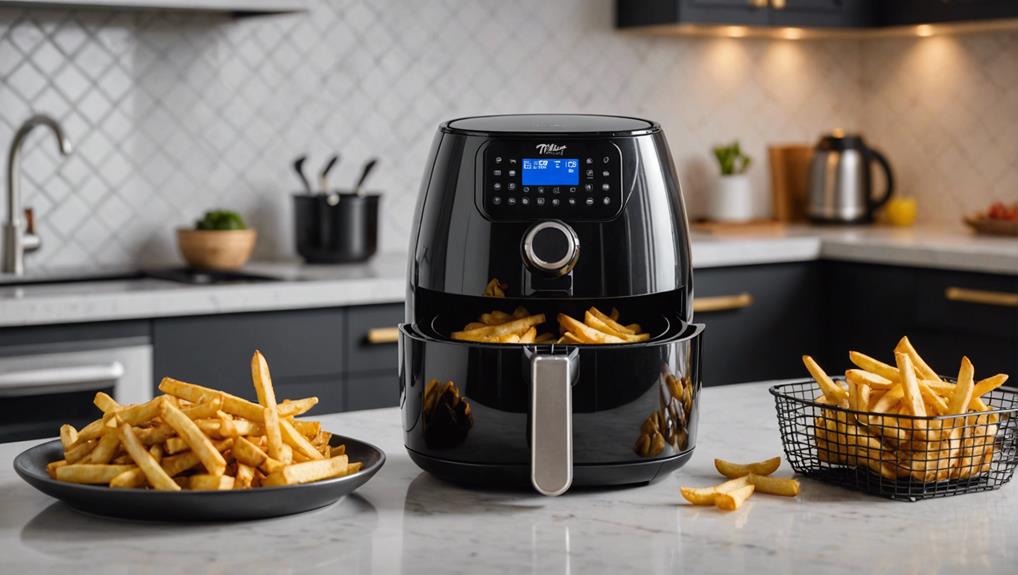
Understanding the role of basket design in air fryers is key to achieving that perfect crispy texture. The basket design is essential because it allows hot air to circulate evenly around the food. This design typically features a perforated basket, which promotes ideal airflow. As the hot air circulates, it dehydrates the surface of the food, leading to a desirable crispy texture.
In air fryers, the basket's perforations mimic the effects of deep-frying by ensuring the food is consistently exposed to heat from all angles. This consistent exposure is vital for achieving uniform crispiness across the entire surface of the food. Without these perforations, the hot air circulation would be impeded, resulting in uneven cooking and less crispiness.
Moreover, the basket design aids in dehydrating the surface of the food. By allowing hot air to flow freely, moisture is efficiently evaporated from the food's exterior. This dehydration process is what gives air-fried food its characteristic crispy texture.
Temperature Control
Temperature control in air fryers is crucial for achieving the perfect crispy texture on your food. By reaching temperatures up to 400°F, air fryers utilize rapid hot air circulation to evenly cook and brown your food, resulting in a desirable crispy exterior. The high temperatures guarantee that the moisture on the food's surface evaporates quickly, which is essential for crisping.
Air fryers come with adjustable settings, allowing you to precisely control the temperature. This feature is essential for tailoring the cooking process to different types of food. For instance, delicate items like vegetables may require lower temperatures to avoid overcooking, while thicker items, such as chicken wings, benefit from higher temperatures for thorough browning and crispiness.
In practice, precise temperature control affects not only the texture but also the evenness of the cooking. Inconsistent temperatures can result in uneven browning, leaving some parts soggy while others are overcooked. Therefore, using the adjustable settings on your air fryer helps maintain ideal conditions for achieving a uniformly crispy result. To summarize, temperature control is a key factor in leveraging an air fryer's hot air circulation to attain the perfect crispy finish on your food.
Oil Usage
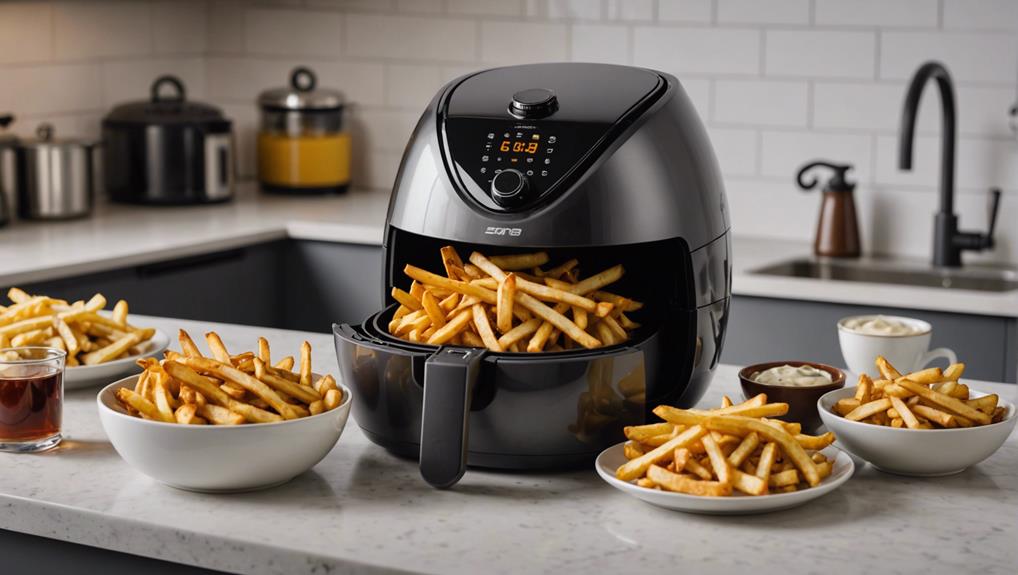
When using an air fryer, a small amount of oil can greatly enhance the crispiness of your food without the need for deep-frying. By adding just a little bit of oil, you can achieve a texture comparable to deep-fried foods. The key lies in the rapid hot air circulation within the air fryer, which crisps up the food evenly and efficiently.
To maximize crispiness, lightly coat or spray your food with oil before air frying. This method allows the hot air to encapsulate each piece, creating a crunchy exterior without excessive grease. Unlike traditional deep-frying, where food is submerged in oil, using an air fryer requires only a fraction of it, making your meals healthier while still delivering that desired crispy bite.
It's essential to understand that the type and amount of oil used can impact the final texture. A little bit goes a long way, and using oils with high smoke points, like canola or olive oil, can further enhance the cooking process. Hence, when using an air fryer, a small amount of oil is your best ally in achieving perfectly crispy results without the downsides of deep-fried foods.
Recipe Examples
To demonstrate the versatility and effectiveness of air fryers, let's explore a few recipe examples that showcase how minimal oil can produce perfectly crispy dishes. One classic dish is air-fried chicken wings. Using your air fryer, coat the wings with a light spray of oil and your preferred seasoning. Cook in an air fryer at 400°F for approximately 25 minutes, flipping halfway through. The result is crispy, golden wings that rival traditional deep-fried versions.
Next, consider air-fried vegetables. Cut vegetables like zucchini, bell peppers, or cauliflower into even pieces. Toss them in a small amount of oil and your choice of herbs. Cook in an air fryer at 375°F for 15-20 minutes. The hot air circulation and perforated basket guarantee even crisping, transforming them into a delightful, crunchy side dish.
French fries are another favorite among air fryer recipes. Slice potatoes into thin strips, lightly coat with oil, and season. Cook in an air fryer at 380°F for 20-25 minutes. These fries achieve a crispy exterior with a soft interior, mimicking the texture of traditional deep-fried fries but using little to no oil.
User Reviews
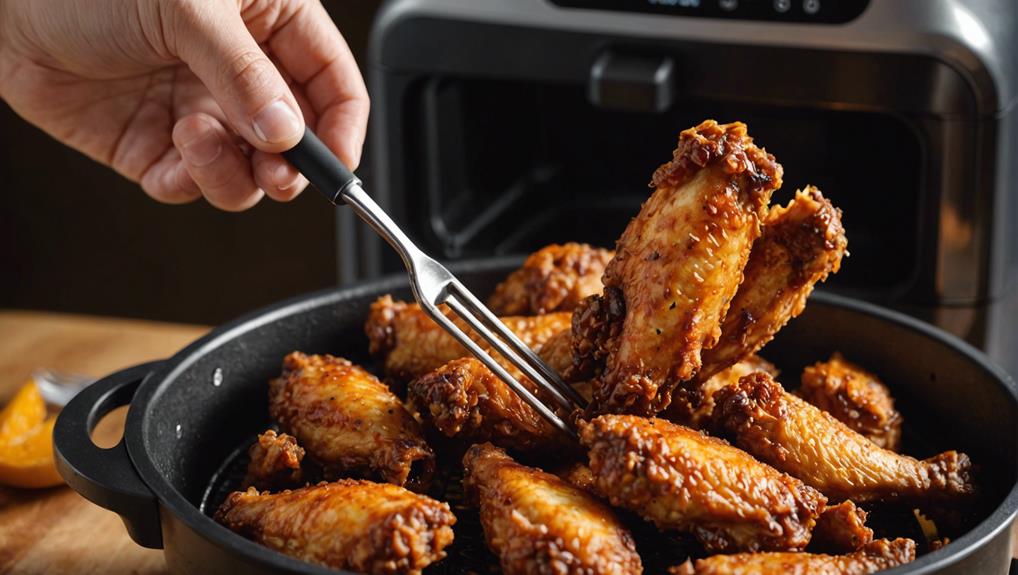
Many users report that air fryers consistently deliver a crispy texture akin to deep-frying, but with significantly less oil. According to user reviews, the circulating air within the air fryer plays an important role in achieving this effect. This cooking method guarantees that the hot air envelops the food uniformly, producing a crispy exterior on items like chicken, fries, and vegetables.
When preparing fried foods, users often mention that a light coating of oil can greatly enhance the crispiness, making the results comparable to traditional deep-frying. Frozen fried foods, such as tater tots, benefit particularly from this cooking method, emerging from the air fryer with an exceptionally crispy texture that closely mimics the taste and feel of deep-fried counterparts.
Air fryer enthusiasts frequently highlight the superior crispiness achieved compared to traditional oven baking. This cooking method has garnered a strong following for producing consistently crispy and delicious results across a wide range of dishes. User feedback consistently underscores the air fryer's ability to replicate the crunchy texture of fried foods while using a fraction of the oil, making it a popular and healthier alternative.
Cleaning Tips
Achieving consistently crispy results with an air fryer also requires proper cleaning and maintenance to guarantee top performance. First, you should clean your air fryer basket and tray after each use. This step prevents food particles and grease from accumulating, ensuring efficient cooking. Wipe out the drip tray regularly to avoid grease build-up, which can hinder airflow and affect cooking efficiency.
For top-notch performance, incorporate a deep clean into your routine. A weekly maintenance regimen is essential to remove any stubborn residue that might not come off during regular cleaning. This involves disassembling the removable parts and washing them with warm soapy water. Pay special attention to any crevices where food particles might be trapped.
Proper maintenance goes beyond just cleaning the visible parts. Make sure the heating element and fan are free from debris, as these components are essential for the air circulation that makes food crispy. Using a soft brush or cloth, gently clean these elements to avoid damage.
Frequently Asked Questions
Why Doesn't My Food Get Crispy in the Air Fryer?
Your food doesn't get crispy due to improper temperature settings, basket overcrowding, lack of preheating, insufficient cooking spray, not flipping food, or high moisture content. Guarantee ideal conditions for the best crispiness results.
How to Get Stuff Crispy in an Air Fryer?
To get stuff crispy in an air fryer, use oil misting, preheating tips, and basket shaking. Apply a bread crumb coating, opt for thin slicing, and adjust temperature settings. These methods guarantee maximum crispiness and even cooking.
What Cannot Be Cooked in an Air Fryer?
You can't cook wet-battered foods, leafy greens, cheese dishes, raw grains, or toasted sandwiches in an air fryer. Wet batters don't set well, and delicate foods like leafy greens and cheese can create a mess.
What Are the Disadvantages of Air Fryer Food?
Studies show air fryers can reduce fat by up to 75%, but you'll face nutrient loss, limited capacity, cooking noise, and appliance cost. Additionally, there's a learning curve, and texture differences can affect your culinary experience.
Conclusion
You might worry that air fryers won't deliver the same crispy results as traditional frying. However, with rapid hot air circulation and minimal oil, air fryers achieve that coveted crunch. Picture golden-brown fries or perfectly crisp chicken wings emerging from the basket—delicious and healthier. By mastering cooking techniques and utilizing the right basket design, you'll consistently produce restaurant-quality crispiness at home. Plus, cleanup is a breeze, making air fryers a practical and efficient choice.
Disclosure: As an Amazon Associate, I earn from qualifying purchases.
